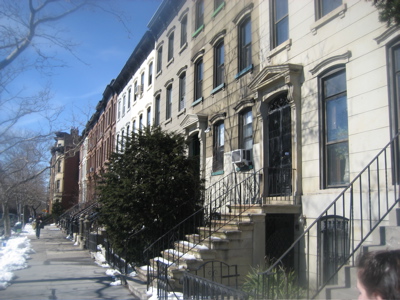Park Slope
From The Peopling of NYC
Park Slope
"Brooklyn's Gold Coast"
Joyce Dweck
Alice Franco
Adele Greenberg
Patricia Multari
Now:
Park Slope is located in the western section of Brooklyn and is part of Brooklyn Community Board 6 and the 78th Precinct. Park Slope takes its name from its location on the western slope of Prospect Park. The neighborhood is bounded by Fourth Avenue, Prospect Park West (Ninth Avenue), Flatbush Avenue, and Fifteenth Street. Its commercial streets are Seventh Avenue and Fifth Avenue while the side streets are known for their many historic Victorian brownstones. Park Slope attracts many families because of its great facilities. Prospect Park is nearby with picnic grounds, tennis courts, baseball diamonds, ponds, a zoo, a lagoon, and a bandstand. The atmosphere in Park Slope is very kid friendly with numerous day cares, public and private schools. There are many bars, restaurants, craft shops, specialty stores including such places as the Park Slope Food Coop. A religious presence is felt in the neighborhood with many historic churches and synagogues. Park Slope is also known for being a home to a thriving homosexual community, though over the recent years less homosexuals have been settling in the area. Generally, the neighborhood has attracted a wealthy upper class and high real estate prices show the demand for houses in the area. On December 6th, 2006 Natural Home Magazine listed Park Slope as one of the top ten best eco-neighborhoods in America.
Then:
However Park Slope wasn't always one of the best eco-neighborhoods in America. From the time of Dutch colonization in the 1600s until the nineteenth century, the land was only used for farming. Edwin L. Litchfield was one of the firsts to buy tracts and settle the area. He also developed industry along the Gowanas Canal. However, it wasn't until the 1870s when Prospect Park was completed that Park Slope began to develop. During that time, row houses, mainly four stories tall and mansions were built. People such as professionals and entrepeneurs began to be drawn to the area because of its easy and short commute to Downtown Brooklyn and Manhatten. This increased with the construction of the Brooklyn Bridge because the bridge provided access to Lower Manhattan. It was during the late 1800s when the the area between Grand Army Plaza to 1st street became known as the Gold Coast of Brooklyn. Mansions were built that imitated those mansions on 5th Avenue in Manhattan. This period was the start of Park Slope's attractiveness.
At the turn of the century, many different immigrant groups began to settle in Park Slope. Less expensive apartment buildings and row houses were built west of 7th Avenue and south of 9th street to accomodate workers at local factories and at the Gowanas Canal. This area became known as the South Slope where immigrants from Puerto Pico, Latin America, the Dominican Republic, Jamaica, and Ireland lived. Between WWI and WWII Irish Immigrants and Irish Americans lived in the working class sections of South Slope. Upper-middle-class residents lived in North Slope where grand structures were being built such as the Classical Revival synagogue on 8th avenue and Garfield Place. In general during this time Italian immigrants were settled in houses at the bottom, earlier Irish immigrants in the middle and old Dutch and English families lived at the top. However during the 1930's and 40's, the Irish had moved up to the top, the Italians up to the middle slope, and blacks and Hispanics had moved into the bottom.
Park Slope took a step back during the 1930s and became an example of urban decline. Luxurious brownstones were turned into rooming houses and other buildings were abandoned. Thirty years later in the 1960s residents began to work on stabilizing the area and recovering the value of these lovely homes. Many organizations were formed to encourage young families to buy homes. In 1973, the New York City Landmarks Preservation Commission designated Park Slope's as a Historic District, to protect and perserve the neighborhood.
